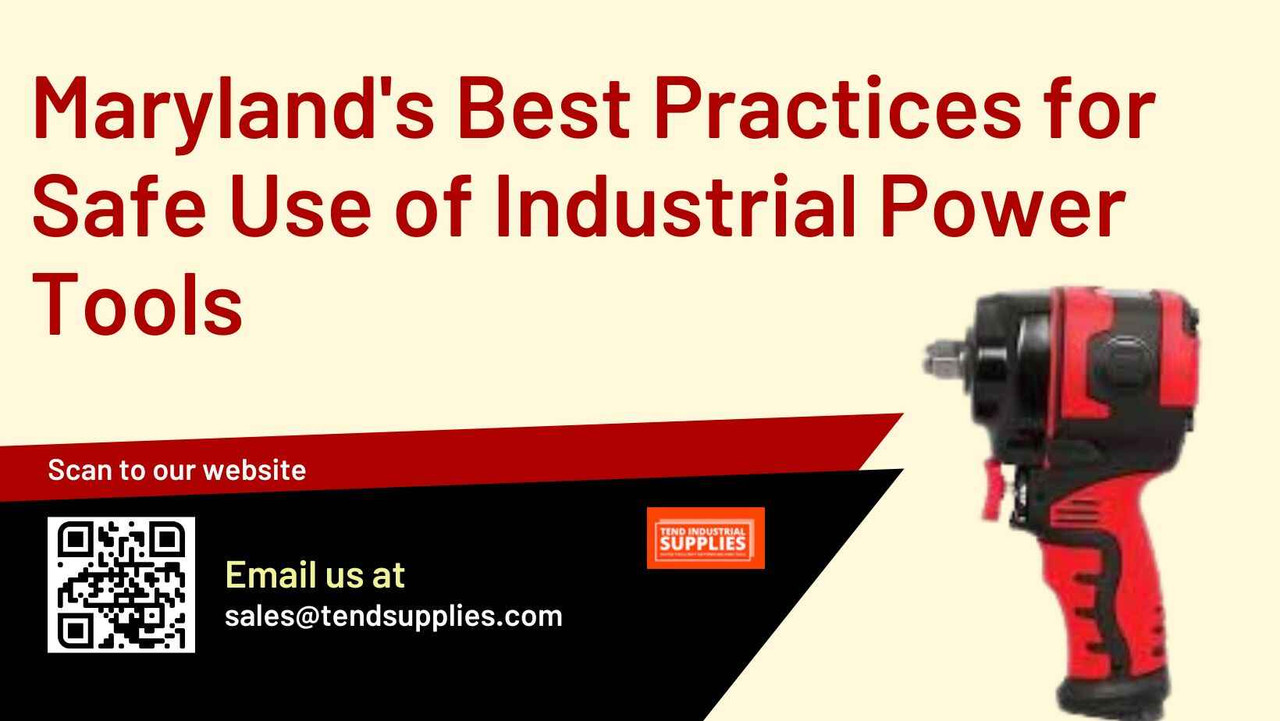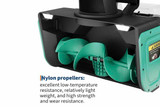Maryland's Best Practices for Safe Use of Industrial Power Tools
Key Takeaways
- Training and Education: A cornerstone of power tool safety in Maryland workplaces, comprehensive training programs equip workers with the knowledge and skills to operate tools safely and effectively.
- Personal Protective Equipment (PPE): Not an option, but a necessity. The right PPE, meeting Maryland's occupational safety standards, shields workers from potential hazards.
- Tool Maintenance and Inspection: Regular maintenance is paramount. By implementing a scheduled program and conducting daily pre-use inspections, businesses can ensure tools are in optimal condition, preventing accidents.
- Adaptable Safety Practices: A one-size-fits-all approach won't work. Maryland's diverse industries, from shipbuilding to biotechnology, require adaptable safety practices to address specific risks.
- Safety-First Culture: Safety isn't just a program; it's a cultural shift. By fostering a safety-first environment, businesses can create a more productive and positive work environment. Cultivating a Safety-First Mindset - EHS Insight
Introduction
Power tools are the lifeblood of industrial productivity, driving efficiency and progress in maryland. However, this power comes with a significant responsibility: ensuring worker safety. This comprehensive guide delves into the best practices for the safe use of industrial power tools in Maryland. We'll explore local regulations, industry standards, and the unique challenges faced by workers across the diverse landscape of Maryland's industrial sector.
Understanding Maryland's Industrial Landscape
Maryland's industrial sector is a rich tapestry woven with distinct threads:
- Manufacturing Powerhouse: Baltimore and surrounding areas hum with the activity of factories producing a wide range of goods.
- Aerospace Innovation: The Capitol region soars with cutting-edge aerospace and defense industries pushing the boundaries of technology.
- Shipbuilding Legacy: Maryland's historic shipbuilding industry continues to thrive along the Chesapeake Bay, constructing and maintaining vital vessels.
- Biotech Boom: The I-270 corridor pulsates with the growth of the biotechnology and pharmaceutical industries, at the forefront of medical advancements.
Each of these industries has its own unique set of power tool requirements and safety considerations. To gain a broader understanding of tools used in various industries, explore our article on The Ultimate Guide to Workshop Tools: Everything You Need to Know.
Essential Safety Practices for Industrial Power Tools in Maryland
Building a foundation of safety starts with robust practices:
1. Proper Training and Education
- Comprehensive Programs: Develop training programs that encompass both general safety principles and tool-specific operations. Workers should be well-versed in the safe use of drills, saws, grinders, and any other relevant equipment used in their specific environment.
- Regular Updates: The industrial landscape is constantly evolving. Regularly update training programs to reflect new tools, processes, safety regulations, and best practices.
- Multilingual Training: Maryland boasts a diverse workforce. Provide training materials and conduct sessions in multiple languages to ensure clear communication and understanding of safety protocols for all workers.
- Certification Programs: Encourage workers to pursue certifications recognized by the Maryland Department of Labor (MDOL). These certifications demonstrate competency and enhance overall safety awareness.
Additional Tips:
- Engaging Training: Utilize a blend of classroom instruction, hands-on demonstrations, and practical exercises to make training engaging and effective.
- Worker Participation: Encourage open communication and active participation during training sessions to address questions and concerns.
- Detailed Records: Maintain comprehensive training records for each worker, documenting their participation and completion of safety programs.
2. Personal Protective Equipment (PPE)
The right PPE is your worker's shield against potential hazards:
- Eye Protection: Safety glasses or goggles that meet ANSI Z87.1 standards are essential for safeguarding eyes from flying debris or sparks. Consider options with anti-scratch and anti-fog coatings for enhanced durability and visibility.
- Hearing Protection: In Maryland's often noisy industrial environments, earplugs or earmuffs with a Noise Reduction Rating (NRR) appropriate for the decibel level are crucial to prevent hearing damage.
- Respiratory Protection: For tasks that generate dust, fumes, or other airborne particles, provide respirators with appropriate filters certified by the National Institute for Occupational Safety and Health (NIOSH).
- Hand Protection: Select gloves that offer dexterity and protection suitable for the specific tools and materials being handled. Cut-resistant, heat-resistant, or chemical-resistant gloves may be needed depending on the application.
- Foot Protection: Steel-toed boots are crucial to safeguard against falling objects. Consider slip-resistant soles for added safety on workshop floors.
Additional Considerations:
- Fit Checks: Conduct regular fit checks for PPE to ensure proper comfort and effectiveness.
- Inspection and Maintenance: Encourage workers to inspect their PPE before each use and report any damage or malfunction immediately.
- Proper Storage: Maintain a clean and organized PPE storage area to promote proper care and accessibility.
By implementing these measures, Maryland businesses can ensure their workers have the necessary protection to operate industrial power tools safely.
3. Tool Maintenance and Inspection
Regular maintenance is crucial for preventing accidents and ensuring optimal tool performance:
- Scheduled Maintenance: Implement a comprehensive maintenance program that includes regular inspections, cleaning, lubrication, and calibration of power tools.
- Daily Pre-Use Inspections: Train workers to conduct thorough inspections before each use, checking for any signs of damage, wear, or loose parts.
- Immediate Removal: Damaged or malfunctioning tools should be removed from service immediately and repaired or replaced.
- Maintenance Logs: Maintain detailed records of all maintenance activities, including inspection dates, findings, and corrective actions.
4. Proper Tool Selection and Use
Choosing the right tool for the job is essential for safety and efficiency:
- Task-Appropriate Tools: Ensure tools are compatible with the specific tasks and materials being handled.
- Ergonomic Design: Consider tools with ergonomic features to reduce worker fatigue and strain.
- Safety Features: Utilize tools with built-in safety features, such as guards, emergency stops, and anti-kickback mechanisms.
5. Workplace Organization and Cleanliness
A well-organized workplace can significantly reduce the risk of accidents:
- 5S or Similar Systems: Implement organizational systems like 5S to maintain a clean, clutter-free environment.
- Storage and Labeling: Ensure tools are stored properly and labeled clearly for easy identification and access.
- Spill Response: Have procedures in place for quickly cleaning up spills of hazardous materials.
- Lighting and Ventilation: Adequate lighting and ventilation are essential for safe and comfortable working conditions.
Maryland-Specific Safety Considerations
- Climate: Maryland's diverse climate requires adaptable safety practices. In humid summers, ensure proper ventilation and hydration. In cold winters, be aware of the impact on tool performance and worker dexterity. For outdoor work, consider weather-resistant tools and appropriate PPE.
- Industry-Specific Practices: Tailor safety practices to Maryland's key industries. For example, in shipbuilding, address corrosion risks and waterproof tool requirements. In aerospace, implement precision tool control and FOD prevention. In biotechnology, ensure tool sanitation and contamination prevention.
- Compliance with Maryland Regulations: Adhere to Maryland Occupational Safety and Health (MOSH) standards, implement safety programs aligned with Maryland's worker protection emphasis, and regularly review and update safety protocols to meet changing state requirements.
Emerging Technologies and Safety Innovations
- Tool Tracking Systems: Implement systems to track tool locations, usage, and maintenance history, ensuring proper accountability and reducing the risk of lost or stolen tools.
- Smart PPE: Explore the use of smart PPE that can monitor worker safety in real-time, detect hazards, and provide alerts.
- Virtual Reality Training: Utilize VR for immersive training experiences, allowing workers to practice safe tool operation in a simulated environment without risk.
Creating a Safety-First Culture
Fostering a culture of safety is crucial for long-term success:
- Open Communication: Encourage workers to report safety concerns without fear of reprisal.
- Safety Incentive Programs: Recognize and reward safe work practices.
- Safety Meetings and Toolbox Talks: Regularly discuss safety topics and address emerging issues.
- Leadership Commitment: Demonstrate strong leadership commitment to safety by prioritizing it in all aspects of the business.
Emergency Response and First Aid
- First Aid Kits: Ensure readily available and fully stocked first aid kits are located throughout the workplace.
- Employee Training: Train employees in basic first aid and CPR to respond effectively to emergencies.
- Emergency Procedures: Develop clear procedures for reporting and responding to accidents, including contact information for local emergency services.
- Regular Drills: Conduct regular emergency drills to ensure workers are prepared to respond effectively in case of an accident.
Frequently asked Questions
- Tool Inspection Frequency: Conduct daily pre-use inspections and more thorough inspections weekly or monthly, depending on usage intensity and tool type.
- Certifications: Check with MDOL for specific certifications required for operating industrial power tools in Maryland.
- Climate Impact: Adjust safety practices seasonally to address humidity, cold weather, and outdoor work conditions.
- Accident Reporting: Report all work-related injuries to MOSH. Severe injuries or fatalities must be reported within specific timeframes.
- PPE Promotion: Implement clear policies, positive reinforcement, and lead by example to encourage consistent PPE use.
Conclusion
Maintaining a safe working environment when using industrial power tools is crucial for Maryland's diverse industrial sector. By implementing comprehensive training programs, ensuring proper use of PPE, maintaining tools regularly, and fostering a culture of safety, Maryland businesses can protect their workers while maintaining productivity.
Ready to elevate the safety standards in your Maryland industrial workplace? Visit tendsupplies.com or contact us at sales@tendsupplies.com to explore our range of industrial-grade power tools and safety equipment. Let us help you create a safer, more productive work environment for your Maryland business!
Related Articles
- The Ultimate Guide to Workshop Tools: Everything You Need to Know
- Mastering Workshop Safety: Essential Tips and Equipment for Tool Handling
- Top 10 Global Air Tools Brands: An Objective Comparison
This comprehensive guide provides detailed information on safe industrial power tool use in Maryland, incorporating best practices, addressing unique challenges, and offering actionable steps for businesses to create a safer working environment







